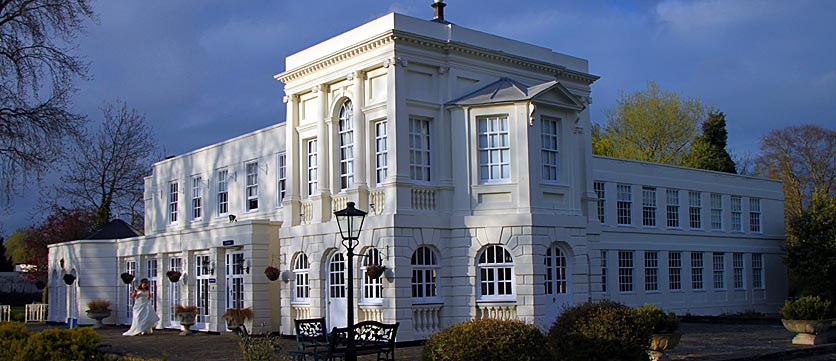 |
 |
|||
|
|
Monkey Island, near the village of Bray, is generally assumed that the Island takes its name from the monkey paintings in the pavilion but this is not correct. The name derives from the earlier title of "Monks Eyot" indicating that the island was being used by Monks, probably in association with their fishery in the Thames. The monks in question resided at Amerden Bank, a moated site near Bray Lock on the Buckinghamshire bank of the river, where a cell of Merton Priory was in existence from 1197 until the Dissolution; holding from the outset "92 acres of land and assant with fishing in the Thames". In the Bray Court Rolls of 1361 the island is called Bournhames Eyte, in a document entitling John Casse and John Tylehurst to use it for pasturage at a charge of 2/6d per annum. The name occurs again in a plan of 1640 when it is referred to as Burnham-Ayt. The words Eyot, Eyte and Ayt are Old English expressions for an island. The land by the 14th Century had clearly passed into the hands of the Canonesses of Burhnam Abbey situated a mile to the North. The island may not have progressed but for the Great Fire of London in 1666. To help in the re-building of the City, Berkshire stone was shipped down-stream to the Capital in barges which on their return carried rubble to be dumped on many of the islands in the Thames, thus providing Monkey Island with a solid foundation for building whilst raising the level to eliminate serious flooding. In about 1723 the island was purchased by Charles Spencer, the 3rd Duke of Marlborough (grandfather of the 5th Duke who was a Berkshire man) . He had seen the property whilst attending meetings of the notorious Kit-Kat Club at nearby Down Place in Water Oakley. The Club which met from 1720 purported to be a gathering of "men of wit and pleasure about town" but beneath a facade of joviality had more sinister objectives concerned with the defence of the House of Hanover. The Duke obviously enjoyed angling: it was he that erected the first two buildings on the island described as a fishing lodge and fishing temple. The Lodge (now the pavilion) was built of wood blocks cut to look like stone and still remains today in its original state — a monument to the craftsmanship of some 200 years ago. The Temple 100 yards from the Fishing Lodge was originally open on the ground floor like a market stall and the attractive room above, once a billiard room, has a fine ceiling with Neptune, shells and mermaids in high relief plasterwork of Wedgewood style, said to be the work of Roberts of Oxford circa 1725. Lady Hertford described the pavilion in 1738 as follows:-"He has a small house upon it, whose outside represents a farm - the inside what you please: for the parlour, which is the only room in it except the kitchen, is painted upon the ceiling in grotesque, with monkeys fishing, shooting etc., and its sides are hung with paper. When a person sits in this room he cannot see the water though the island is not above a stone's cast over: nor is he prevented from this by shade: for, except for six or eight walnut trees and a few orange trees in tubs there is not a leaf upon the island; it arises entirely from the river running very much below its banks." The Monkey paintings mentioned by Lady Hertford were painted by a French artist, Andie de Clermont. They were clearly painted before 1738. The Monkey Room as it is now known, with its spectacular ceilings, was once used as a banqueting room and depicts monkeys in several river scenes fishing, shooting, boating, all dressed in the fashion of the day. By 1840 the pavilion had become a riverside inn which could be reached by ferry from the South bank. Visitors have been staying in various parts of the two buildings ever since. It became particularly fashionable after the turn of the 20th century when Edward VII and Queen Alexandra often had afternoon tea on the lawns with their children. Rebecca West and HG Wells and other notable authors are known to have visited the island on occasions and may well have been inspired by its peace and tranquility. The footbridge was not built until 1956, and additional rooms were added in 1963 retaining the original building as a centrepiece. The Temple had become a private residence until in 1970 still more rooms were added and the property became the Monkey Island Hotel with the original fishing lodge and temple scheduled as Grade I listed buildings. The Lodge and Temple are now the Monkey Island Hotel. From 'A Little History' prepared for the hotel by Luke Over.
|
|||
| © Text - Luke Over; Image - Nash Ford Publishing 2012. All Rights Reserved. | ||||



